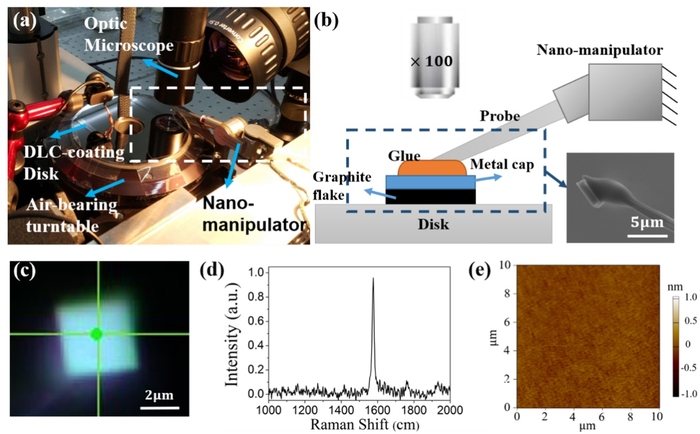Reviewed by Alex SmithAug 31 2021
Developing long-lasting and durable devices is a long-time human intention. Yet, contemporary devices have limits on the product life due to the wear factor. Moving devices with infinite lifetime exist only in Sci-fi nowadays.
 Photos of experimental setup. (b) Schematic of experimental setup. (c) Optical microscope image of the sliding surface (contacting the substrate) of one graphite flake after the sliding experiment. (d) Raman spectroscopy characterization results. (e) Morphology characterization using AFM of the sliding area on a DLC film. Image Credit: Science China Press.
Photos of experimental setup. (b) Schematic of experimental setup. (c) Optical microscope image of the sliding surface (contacting the substrate) of one graphite flake after the sliding experiment. (d) Raman spectroscopy characterization results. (e) Morphology characterization using AFM of the sliding area on a DLC film. Image Credit: Science China Press.
In present-day industrial societies, almost 80% of device failures are caused by wear. This causes huge economic losses, resource wastage and environmental pollution. At the micro-level, as a result of notable surface effects, the wear of micro-devices is very severe compared to that of macro-devices.
Conventional lubrication techniques, like using lubricating oil, are often challenging to employ in micro-devices. This affects many significant designs of devices from turning into a reality. For instance, the first micro-motor in history created by researchers at the University of California, Berkeley in 1988 failed soon after it started running due to severe wear.
Structural superlubricity (SSL) is the contact state where two solid surfaces in full contact ensure near-zero friction and zero wear during sliding. This offers a basic solution to the issue of wear of devices.
A research team led by Professor Quanshui Zheng at Tsinghua University, China, employed SSL systems comprising graphite and diamond-like carbon (DLC) films that succeeded in delivering a wear-free sliding for a distance of up to 100 km with a sliding speed of 2.5 m/second in an ideal environment.
The scientists mounted a micro-scale graphite flake to the top of a probe and utilized a nano manipulator to control the graphite flake to contact with an atomically smooth DLC film on a disk. The position of the graphite flake in the experiment is static, and the rotation of the disk causes relative sliding between the graphite flake and the DLC film. An optical microscope was employed to trace the sliding status of the graphite flake on the disk instantly.
The researchers were able to control the rotation speed of the disk at 2.5 m/second and executed a sliding experiment for the graphite flake having a total of 108 km sliding distance and 12.5 hours sliding time. Post sliding experiment, the scientists conducted Raman spectroscopy characterization on five points (one at the center and four in the encircling areas) on the sliding surface of the graphite flake. However, no D peaks were detected.
This implies that the sliding surface of the graphite flake was still intact post sliding for the very long distance of 108 km. The researchers also employed an atomic force microscope to characterize the sliding areas on the disk and observed no traces of wear.
Additionally, the researchers quantified the relationship between the friction and the normal pressure and traced the frictional stress, which ranged only about 0.02 MPa (the normal pressure was 40 μN), and the friction coefficient (the derivative of friction with respect to load) was around 0.005.
When the normal pressure was more than 30 μN, the friction coefficient was also of the order of magnitude of 0.001, which fulfills the definition of superlubricity (that is, the friction coefficient is of the order of magnitude of 0.001 or lower).
A graphite flake was possibly observed as a pile of stacked sheets of graphene. Graphene is a van der Waals two-dimensional material, and the interaction force between it and DLC is van der Waals force, which might be the reason for the extremely low friction between them.
For verifying this aspect, the researchers further quantified the friction between graphite flakes and six other kinds of materials, namely sapphire, silicon oxide, silicon, aluminum oxide, mica and hafnium oxide. All these materials have van der Waals interactions with the graphite flake.
The outcomes reveal that the coefficients of all six groups are of the order of magnitude of 0.001. Through numerical simulations and calculations, the scientists also learned that the state of contact between the graphite flake and these materials was full contact. The full-contact state eliminates edge effects, stress concentration and other factors that could destroy the superlubricity state.
Depending on several pieces of evidence mentioned above, the scientists expect that the van der Waals interaction at the interface, the full contact state, the atomically smooth surface and the extremely high in-plane strength of graphene can form an exceptionally high wear resistance between the graphite flake and the DLC film.
Dr. Deli Peng from Tsinghua University is the first author of the paper, and Professor Ming Ma and Professor Quanshui Zheng are the co-corresponding authors of the study. The co-authors of the paper also include Dr. Jin Wang, Dr. Haiyang Jiang, Dr. Shuji Zhao, PhD student Zhanghui Wu and Dr Kaiwen Tian from Zheng’s team.
Journal Reference:
Peng, D., et al. (2021)100 km wear-free sliding achieved by microscale superlubric graphite/DLC heterojunctions under ambient conditions. National Science Review. doi.org/10.1093/nsr/nwab109.